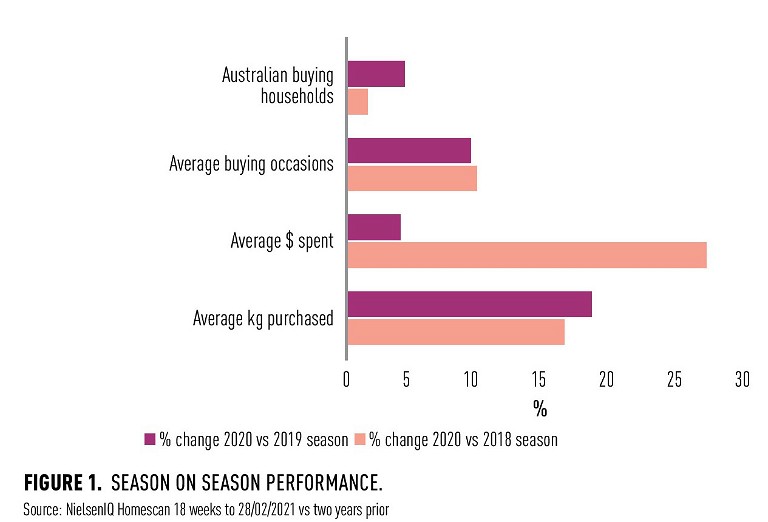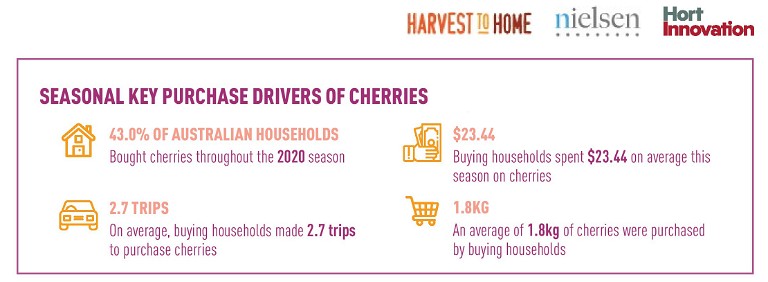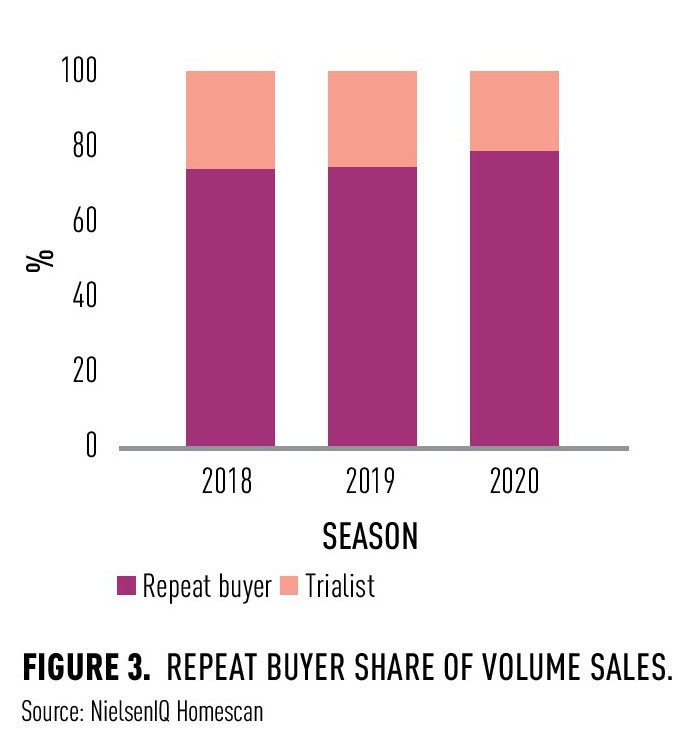Bumper cherry season stems from lower prices
BY LEWIS MUSCAT MANAGER FRESH ANALYTICS, NIELSEN

MORE than two-in-five Australian households purchased cherries in the 2021 season.
For many Australians, spotting the first cherries of the season heralds the arrival of summer and the festive season.
Christmas and cherries go hand in hand with summer and socialising and it’s not unusual to see a display of these shiny, sweet, and rich-coloured stone fruit taking pride of place on the Aussie Christmas dining table and across summer occasions.
The domestic cherry season typically lasts around 100 days from late October to February and NielsenIQ Homescan research reveals that 2021 was a bumper season for Australian cherries. For the 18 weeks ending 28 February 2021, cherry consumption (volume sold) was up by a staggering +33.2% versus the same period in 2020, while dollar sales increased +17.0%.
The performance of this year’s cherry crop was also significantly greater than the 2019 season in both volume (+23.8%) and dollar terms (+35.3%).
The latest season was met with favourable growing conditions and steady rainfall resulting in consumers having access to bountiful supply and lower prices.

The 2021 season saw the average price per kilogram for cherries decline by -12.2% compared to the 12 months prior, but still +9.3% higher than 2019.
Two-thirds (66.3%) of all cherry volume sales were sold loose, while 33.7% were sold pre-packed. While loose cherries represented 64.1% of total volume growth for cherries, pre-packed still had a higherthan-expected growth contribution (35.9%) given its overall share position.



Shopper behaviour
In the 2020–21 season more shoppers purchased cherries, with shoppers purchasing more than they usually would and far more frequently. More than two-in-five (43.0%) Australian households purchased cherries in the 2021 season — an increase of +4.4% of Australian homes versus the previous year (see Figure 1). During this period, shoppers purchased cherries 2.7 times on average (+9.4% versus 2020) and spent a total of $23.44 for around 1.8 kilograms of the fruit.
Repeat buyers — those who purchased more than once in the season — are incredibly important to the cherry category. This group of buyers represented 56.8% of all cherry buyers (see Figure 2) and accounted for more than three-quarters (78.6%) of all volume sales (see Figure 3).
The post-Christmas opportunity
Cherry sales have a strong dependency on Christmas as the peak consumption period.
Cherry sales have a strong dependency on Christmas as the peak consumption period. The first nine weeks of the 18-week cherry season includes Christmas and made up 69.1% of all volume sales, compared to the second half of the season which only accounted for 30.1%.
To encourage strong cherry consumption right through the season, growers and retailers should continue to work together to guarantee the availability of the fruit from the first to the last domestic harvest. While cherries are a great-tasting and affordable gift option for Christmas, continued marketing activity that focuses on driving demand across the summer period will help build on the already growing consumption post-Christmas. Making cherries available in convenient, pre-packed sizes to suit different household types, messaging that centres on cherries as an indulgent but much healthier treat, recipe ideas for smoothies, smoothie bowls, homemade sorbet and snack bars, may help to encourage consistent buying across the season.
MORE INFORMATION
FOLLOW WA STONEFRUIT

@wastonefruit

@WeLoveWAStonefruit